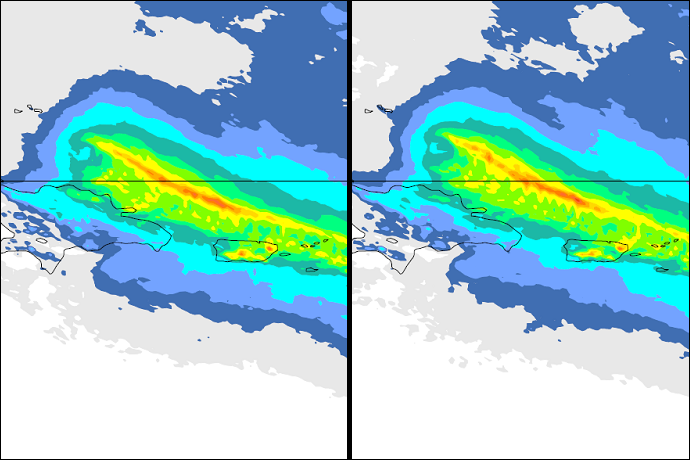

Recent investigations suggest that the equations ECMWF uses to forecast the global weather may not have to be updated to much more computationally demanding ones as long as the weather model’s horizontal grid spacing is no smaller than 2.8 km.
Further tests will be carried out to see whether the current equations can predict the weather successfully at even smaller grid spacings, such as 1.4 km.
The horizontal grid spacing of ECMWF’s Integrated Forecasting System (IFS) in the medium range is currently 9 km, so there is some way to go before the system runs into problems. However, our work for the EU’s Destination Earth (DestinE) initiative is set to involve horizontal grid spacings of 2–4 km.
Hydrostatic versus non-hydrostatic
The fundamental equations ECMWF currently uses to predict the weather are called ‘hydrostatic’ because they rely on the assumption of hydrostatic equilibrium. This describes an atmospheric state in which the decrease of pressure with height is balanced by the gravitational pull of the Earth.
On average, the Earth’s atmosphere is always very close to hydrostatic equilibrium. This fact has been used to approximate the equations underlying ECMWF’s weather prediction model (H-IFS).
Thanks to collaborative development led by our Member State partner Météo-France, a non-hydrostatic version of the model used by ECMWF is also available (NH-IFS).
Using it to test the demanding high-resolution global computational domains of the IFS, which extend up to 80 km in height and include the major topographic barriers of the Himalayas and the Andes, initially caused stability problems for medium-range forecasts.
Recent work by ECMWF scientists has resolved these issues, making it possible to conduct systematic comparisons at fine grid spacings. NH-IFS is about twice as computationally demanding as H-IFS, but it can be used to test H-IFS at high resolutions.
Test cases
Tests conducted so far suggest that, in the troposphere, forecasts are different in only negligible ways if NH-IFS and H-IFS are used at a grid spacing of 2.8 km. The following is, for example, a forecast of precipitation related to Hurricane Irma in September 2017.

Total precipitation in 5-day forecasts of Hurricane Irma from 3 September 2017, 00 UTC, using NH-IFS (top) and H-IFS (bottom) at 2.8 km horizontal grid spacing.
Forecasts of the minimum central pressure and the maximum sustained wind speed are also very similar in the two systems.

Forecasts of minimum central pressure and maximum sustained wind speed of Hurricane Irma from 3 September 2017, 00 UTC, using NH-IFS and H-IFS at 2.8 km horizontal grid spacing.
“We have carried out a broad range of comparative tests, and the only place where we have found substantial differences is in some conditions in the stratosphere over the Himalayas,” says ECMWF scientist Inna Polichtchouk.
Those differences relate to strong surface winds, where using NH-IFS leads to a reduction in resolved gravity wave flux in the upper troposphere. This results in reduced deceleration of the subtropical jet in the lowermost stratosphere, which is beneficial for forecast scores there.
But in the troposphere, no essential differences between the two forecasting systems have been found so far.
“Although this seems to contradict established theory based on scale analysis, which says that for length scales below 10 km the hydrostatic approximation is not accurate, in fact it agrees with it,” says ECMWF scientist Michail Diamantakis. “It is more useful to think in terms of horizontal effective resolution rather than merely grid resolution.”
In simple terms, the effective resolution is the smallest length scale that a model can fully resolve. In the case of the IFS octahedral grid, the effective resolution is larger than the grid spacing by approximately a factor of six.
Implications
The results suggest that forecasts for the troposphere with a grid spacing of 2.8 km could go ahead with the current hydrostatic model. “Next, we’ll finalise the assessment of 2.8 km resolution and see how H-IFS compares with NH-IFS at 1.4 km,” says Michail. “The tests performed so far are a good sign for the DestinE initiative, which intends to perform many simulations with a grid spacing of 2–4 km in the coming years.”
As a backup plan for even smaller resolutions, ECMWF is developing a different non-hydrostatic dynamical core. This system, called FVM, relies on a finite-volume discretisation with local low-volume communication cost, which also has the advantage that it conserves mass both locally and globally.
Parallel efforts to develop a weather forecasting system based on machine learning, the AIFS, do not face the same computational issues as the traditional IFS. This is because the AIFS does not solve any physical equations but is purely data-guided. However, it is still at a very early stage in its development, with a resolution of approximately 1 degree (111 km) and a limited range of parameters.
